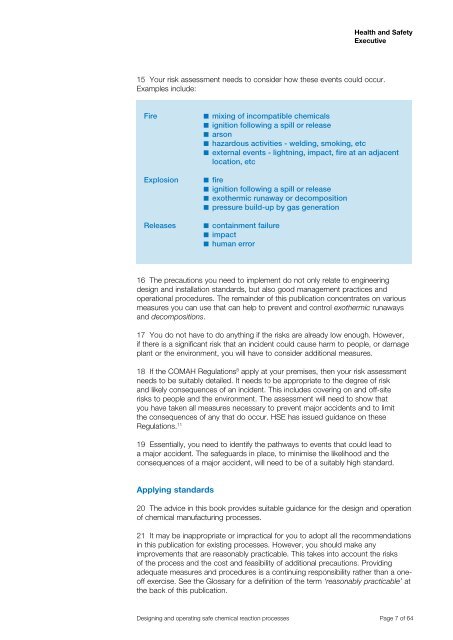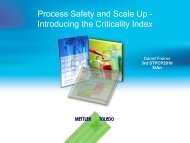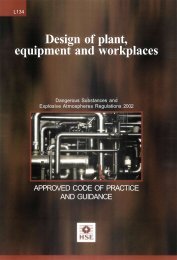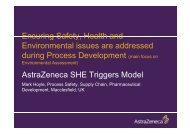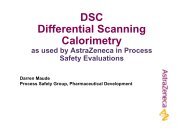Designing and operating safe chemical reaction processes HSG143
Designing and operating safe chemical reaction processes HSG143
Designing and operating safe chemical reaction processes HSG143
Create successful ePaper yourself
Turn your PDF publications into a flip-book with our unique Google optimized e-Paper software.
Health <strong>and</strong> SafetyExecutive15 Your risk assessment needs to consider how these events could occur.Examples include:FireExplosionReleases■■mixing of incompatible <strong>chemical</strong>s■■ignition following a spill or release■■arson■■hazardous activities - welding, smoking, etc■■external events - lightning, impact, fire at an adjacentlocation, etc■■fire■■ignition following a spill or release■■exothermic runaway or decomposition■■pressure build-up by gas generation■■containment failure■■impact■■human error16 The precautions you need to implement do not only relate to engineeringdesign <strong>and</strong> installation st<strong>and</strong>ards, but also good management practices <strong>and</strong>operational procedures. The remainder of this publication concentrates on variousmeasures you can use that can help to prevent <strong>and</strong> control exothermic runaways<strong>and</strong> decompositions.17 You do not have to do anything if the risks are already low enough. However,if there is a significant risk that an incident could cause harm to people, or damageplant or the environment, you will have to consider additional measures.18 If the COMAH Regulations 8 apply at your premises, then your risk assessmentneeds to be suitably detailed. It needs to be appropriate to the degree of risk<strong>and</strong> likely consequences of an incident. This includes covering on <strong>and</strong> off-siterisks to people <strong>and</strong> the environment. The assessment will need to show thatyou have taken all measures necessary to prevent major accidents <strong>and</strong> to limitthe consequences of any that do occur. HSE has issued guidance on theseRegulations. 1119 Essentially, you need to identify the pathways to events that could lead toa major accident. The <strong>safe</strong>guards in place, to minimise the likelihood <strong>and</strong> theconsequences of a major accident, will need to be of a suitably high st<strong>and</strong>ard.Applying st<strong>and</strong>ards20 The advice in this book provides suitable guidance for the design <strong>and</strong> operationof <strong>chemical</strong> manufacturing <strong>processes</strong>.21 It may be inappropriate or impractical for you to adopt all the recommendationsin this publication for existing <strong>processes</strong>. However, you should make anyimprovements that are reasonably practicable. This takes into account the risksof the process <strong>and</strong> the cost <strong>and</strong> feasibility of additional precautions. Providingadequate measures <strong>and</strong> procedures is a continuing responsibility rather than a oneoffexercise. See the Glossary for a definition of the term ‘reasonably practicable’ atthe back of this publication.<strong>Designing</strong> <strong>and</strong> <strong>operating</strong> <strong>safe</strong> <strong>chemical</strong> <strong>reaction</strong> <strong>processes</strong> Page 7 of 64


